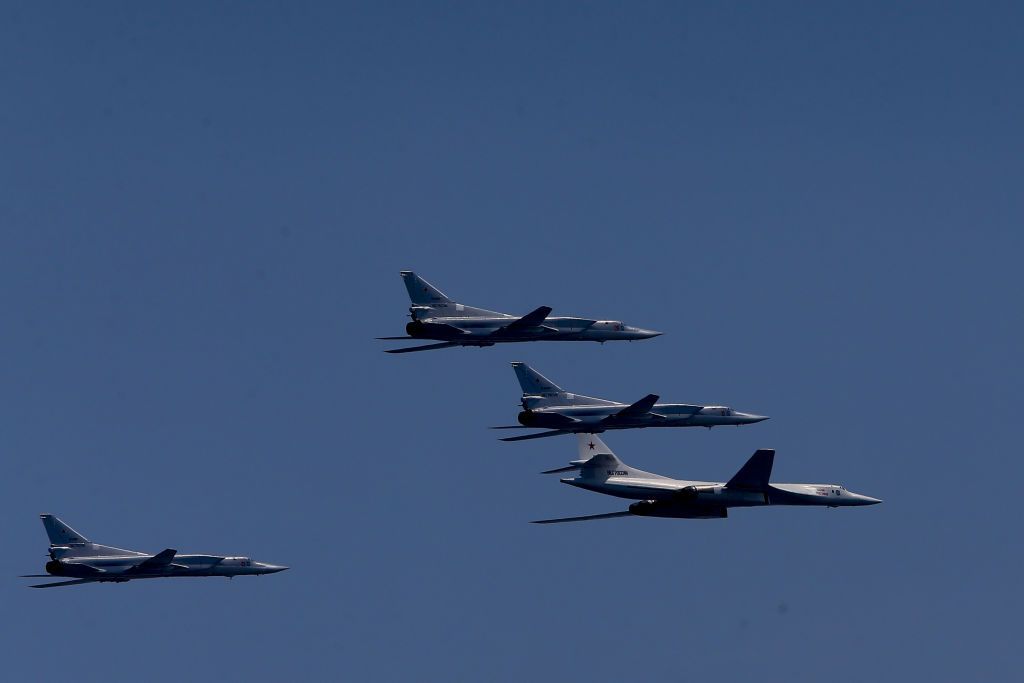
Ukraine's obsolete S-200 missile systems reportedly back on track to hit Russian targets
In an undated photo a Soviet-built S-200 surface-to-air missile displayed in the Hungarian military museum Pintér Művek Haditechnikai Park. (Wikimedia)
The first Russian Tu-22M3 long-range strategic bomber was reportedly shot down by Ukraine and crashed over Russia's Stavropol Krai overnight on April 19.
The aircraft was carrying out a combat mission when a Soviet-era S-200 anti-aircraft system shot it down, an intelligence source told the Kyiv Independent.
The Russian Defense Ministry claimed the aircraft crashed due to a "technical malfunction" while returning to its base.
The Kyiv Independent could not verify these claims.
"It was a kind of vendetta for the fact that Russian strategic aviation attacked our peaceful cities today, where civilians were killed," Illia Yevlash, a spokesperson for Ukraine's Air Force, told Radio Free Europe/Radio Liberty (RFE/RL).
Russia regularly uses the Tu-22M3 bomber planes in the all-out war against Ukraine to launch Kh-22 anti-ship missiles designed to destroy aircraft carriers. Overnight on April 19, Russian forces attacked the country with 22 missiles, including six Kh-22s, according to the Air Force.
Two of them were reportedly shot down by Ukraine for the first time since the beginning of the war. At the same time, another partially destroyed a five-story building in Dnipro, killing three people and injuring 24 others.
Kyrylo Budanov, Ukraine's military intelligence chief, said that the plane was hit at a distance of 308 kilometers after a week of "ambush." The Air Force and military intelligence were behind the operation.
"We were waiting for it to reach the right frontier," he said in an interview with BBC News Ukraine.
"Fruitful and long work makes itself felt. (The plane was struck) with the same methods and tools that we used to destroy the A-50 in the air."

Ukraine is said to have destroyed two rare Russian A-50 military spy planes, the last of which was reportedly hit over Russia's territory, near the town of Yeysk, about 200 kilometers from the front line.
The aircraft was shot down using an old Soviet-made S-200 air defense system that was scrapped by Ukraine a decade earlier and revitalized after the start of the full-scale invasion.
The alleged downings of the A-50 planes and the Tu-22M3 bomber show how Ukraine, short on Western weapons and ammunition, reinvents the way it's forced to fight.
Obsolete weapons
The S-200, also known as SA-5 Gammon, is a long-range surface-to-air missile system originally developed in the Soviet Union and first accepted into service in the late 1960s. Since then, the system has been modernized several times.
Initially, it was designed to strike American bombers and other strategic aircraft during the Cold War.
The systems could use missiles of several modifications, the latest of which could travel up to 300 kilometers and counter air targets at altitudes up to 40 kilometers. The 5V28V variant weighs 7,100 kilograms and is around 11 meters long.
Despite its range of capabilities, the S-200 was a stationary system that took time to deploy and needed rails to move.
The S-200 system was widely exported by the Soviet Union, including to Bulgaria, Hungary, Poland, Syria, and Libya.
Some suggest that even if Ukraine uses S-200 missiles now, they may not be from its own stockpiles previously scrapped, Andrii Kharuk, a military historian and weapons expert, told the Kyiv Independent.
"But those that have been kept in good condition, supplied previously, for example, from Poland or Bulgaria, where these missiles are still in service," he added.

Ukraine operated the S-200 until 2013. The last batteries were officially withdrawn from service after the government decided to decommission the systems due to their obsolescence.
It is unknown whether these systems have been stored in warehouses and in what condition.
"The S-200 was the only long-range system capable of covering large industrial areas, destroying aircraft on approach to the borders of Ukraine, and remained one of the factors of possible deterrence," Militarnyi, a Ukrainian military-focused news outlet, reported.
In 2018, then-First Deputy Defense Minister Ivan Rusnak announced the willingness of some enterprises to return S-200 systems to a combat-ready state. He said Ukraine would need up to a year to restore them while the missiles were available.
How many of them have been revitalized is unknown.
Possible upgrade
Rumors that Ukraine once again uses S-200 missiles began circulating in the summer of 2023.
The Russian Ministry of Defense claimed that "converted" S-200 missiles had been shot down over Rostov, Kursk, and Kaluga oblasts, as well as occupied Crimea.
Ukraine's military has not officially confirmed these claims while Kyiv is ramping up the production of domestically-made weapons, including long-range drones, which reportedly have already hit targets deep inside Russia.
"In the current circumstances, we have to search for a way out. We have come up with these S-200s, and it seems to be working well so far," an unnamed government source told BBC News Ukraine in August 2023.
Defense Express reported that the S-200 can be repurposed for ground attacks, but a few changes are needed to make missiles more effective and accurate. They include redesigning the guidance system and warhead and developing a ground-based mobile launcher.
It will not be possible to make new missiles based on the S-200 from scratch due to rather complicated technology, but it is possible to repair the previously produced ones to combat readiness, according to Kharuk.
"I think we are not talking about modifying these missiles, but only about restoring their readiness. We can talk about modifying the ground equipment, introducing modern means of communication, and incorporating modern detection radars," he added.
"If until now the crews of Russian strategic bombers felt completely unpunished, now they see that they can be reached. Let's hope this is the first such step."












